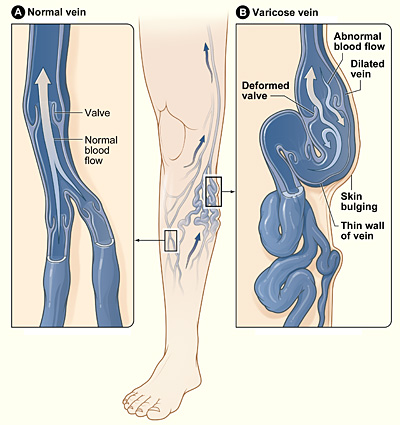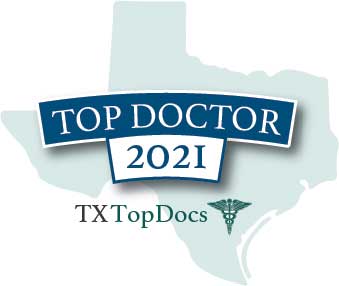Therapy For Varicose Veins – Look and Feel Rejuvenated
With the correction of varicose veins, you’ll feel as good as you look. The Vein Treatment Center of Texas can help.
What are Varicose Veins?
Varicose veins are defective veins that are abnormally enlarged when compared to adjacent normal veins. Varicose veins lie beneath the skin surface and appear to bulge and protrude from beneath the skin. They have a tortuous/serpentine appearance, having a worm-like look to them.
Varicose veins have abnormally thin walls and tend to exert pressure on the overlying skin. Inside the defective veins are defective vein valves that are broken and dysfunctional. Therefore these defective veins cannot properly control the direction of blood flow. Varicose veins are under much higher pressure than normal veins since gravity causes blood to “pool” and stagnate in these broken veins. The defective and “backward” blood flow that exists inside of varicose veins is referred to as venous reflux.
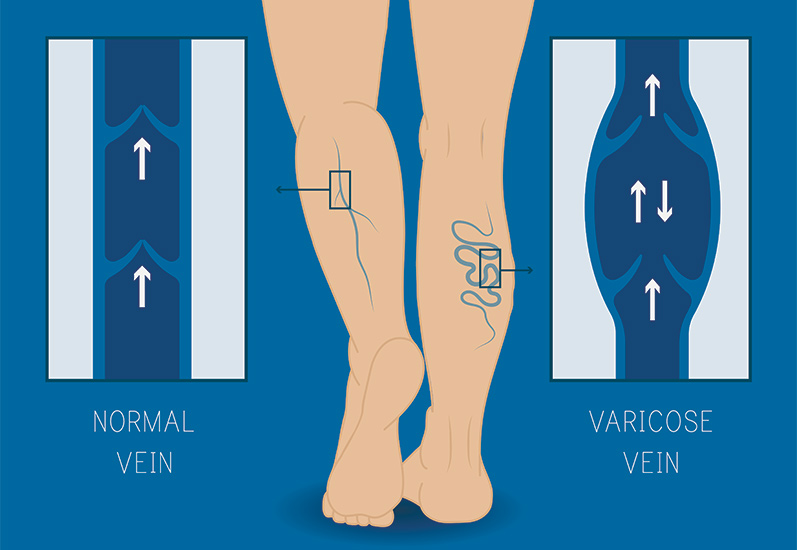
Why Do Varicose Veins Form?
Varicose veins are typically a hereditary problem that you are born with. Thus varicose veins are referred to as a genetic vein condition. Most people who develop varicose veins have a known relative with the same condition, usually a parent or grandparent. If you inherit the varicose vein gene you will inevitably develop varicose veins as you age. Women are more likely to develop varicose veins than men. But is it common for men to develop varicose veins as well.
Direct damage to previously normal veins may also cause varicose veins to develop. If the wall of a normal vein is damaged due to trauma, injury, or blood clots then the injured veins can develop into varicose veins.
Pregnancy, obesity, and sedentary lifestyle will all aggravate and accelerate the development of varicose veins, but these factors alone will usually not directly cause varicose veins. It typically requires the underlying genetic predisposition to be present as well.
Where In the Body Do Varicose Veins Form?
The most common location for varicose veins to develop is the legs. The lower legs are more commonly affected than the upper legs, but it is also rather common to develop varicose veins in the upper and lower legs at the same time. Leg varicose veins frequently extend into the ankles and feet as well.
The second most common location for varicose veins to develop is in the groin, pelvis, and genital area. These often first show up during pregnancy or may significantly worsen during pregnancy.
Varicose veins, in theory, can potentially form in any area of the body, but in reality, varicose veins rarely form any higher than the pelvis. When abnormal veins develop above the pelvis they are usually not classified as varicose veins, but rather they are typically the result of a different disease process. Examples include venous malformation, collateral veins, and varices secondary to liver disease.
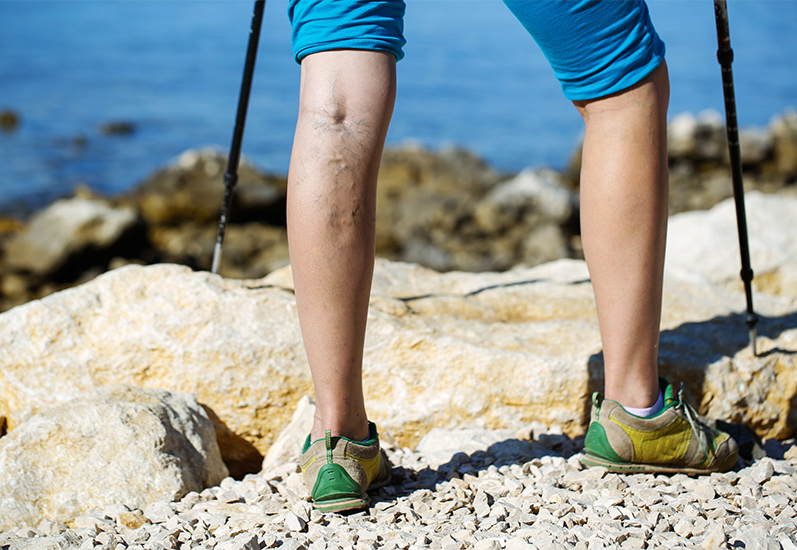
Will Varicose Veins Worsen Over Time?
Unfortunately, varicose veins will almost always worsen over time. The age at which they first develop varies tremendously from person to person. But no matter what age varicose veins develop, they will always get more severe over time. Some people develop varicose veins when they are teenagers. Other may not see varicose veins from until they are elderly. Most people first see varicose veins develop during midlife. Many women do not see their varicose veins develop until they get pregnant. If varicose veins are present before pregnancy than it is often beneficial for varicose veins to be treated before a person gets pregnant since varicose veins can otherwise worsen dramatically during pregnancy.
The more time that elapses from the onset of the condition the more the varicose veins worsen. Varicose veins gradually enlarge, multiply, and spread to more areas. Therefore the earlier that varicose veins are treated the better the long-term outcome.
Varicose veins can often be cured. The earlier that varicose veins are treated the higher the chance of a long-term cure and the lower the chance of recurrence.
Vein Symptoms
Varicose veins can lead to many different types of symptoms. Almost all of these symptoms are located in the legs or pelvis. Leg symptoms are the most common. The symptoms can include aching, throbbing, burning, cramping, dull or sharp pains, leg fatigue, itching, and restless legs. Symptoms most commonly occur in the lower legs. The leg symptoms can frequently occur in areas away from the sites where the varicose veins are visible at the surface.
In addition to symptoms of discomfort, many people with varicose veins also exhibit symptoms of swelling of the legs, ankles, and feet. This swelling is often referred to as edema. Skin changes are also very common. This includes pigmentation of the skin which is usually tan or brown in color. The discoloration most frequently involves the ankles and feet. Skin dermatitis is also common. Dermatitis can present as redness and itching of the skin, flakiness of the skin, and thickening or firmness of the skin.
Some people may not develop any symptoms from their varicose veins. They may seek medical evaluation for strictly cosmetic reasons.
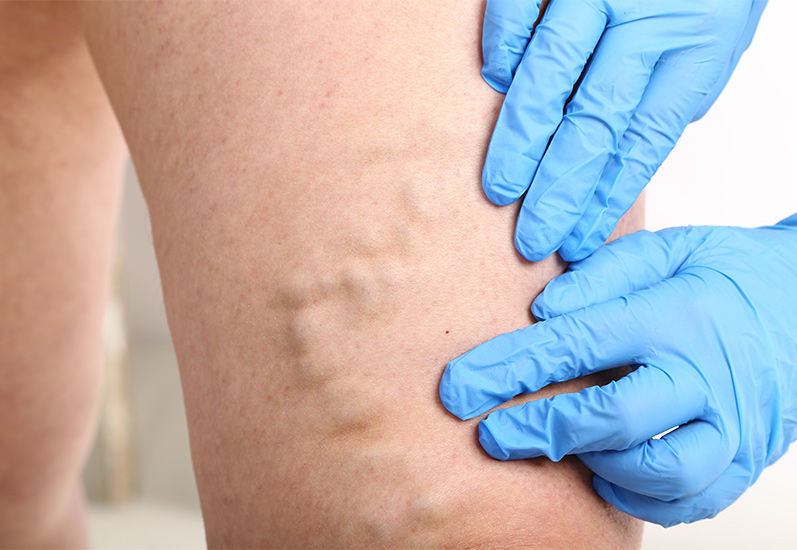
Complications That Can Occur With Leg Veins
Varicose veins can lead to various complications, some more severe than others. These complications may include the development of skin ulcers and wounds that are slow to heal. These wounds most frequently occur on the ankle and feet.
Blood clots, which can be both superficial and deep can also occur. Blood clots inside veins are referred to as venous thrombosis. Inflammation within the veins can lead to sudden redness, tenderness, hardness, and pain at the location of varicose veins. This is referred to as phlebitis or thrombophlebitis.
Vein bleeding is another complication that can occur from varicose veins. The hemorrhage typically occurs at sites where the skin has gotten very thin from the underlying vein pressure. The bleeding can sometimes be severe and difficult to control. Other times is it mild but intermittent and recurrent in nature.
Interventional Treatments
There are 3 categories of interventional varicose vein treatments currently available. These vein treatment categories are surgery, thermal therapies, and medication injections. These options are briefly discussed below.
Surgical Treatments include traditional surgical removal of varicose veins. These surgeries are sometimes performed under local anesthetic in the office while other times they are performed under anesthesia at a surgery center or hospital. The most common surgical procedures are phlebectomies, vein ligation, and vein stripping. Although more commonly utilized in the past, surgical vein treatments are much less common today. These surgery treatments have decreased in frequency due to improved technologies and better medications which often allow for less invasive options.
Thermal treatments involve the delivery of heat energy to treat varicose veins. The most common of these therapies are listed below:
- Laser. Laser heat is used to treat many different medical conditions, including varicose veins. The most commonly performed laser procedure for varicose veins is called the EVLT procedure. EVLT stands for “EndoVenous Laser Treatment”. This is a minimally-invasive procedure that is performed through a catheter entry site and therefore does not require any incisions on the skin.
- Radiofrequency heat. This is a minimally-invasive procedure called the ClosureFast procedure or radiofrequency ablation. It is performed through a catheter entry site and therefore does not require any incisions on the skin.
Medication injection is a very common method of removing veins. There are several types of medication therapies that are very effective in resolving varicose veins. Which type of medication that is utilized depends upon the size, location, and shape of the vein(s) being treated.
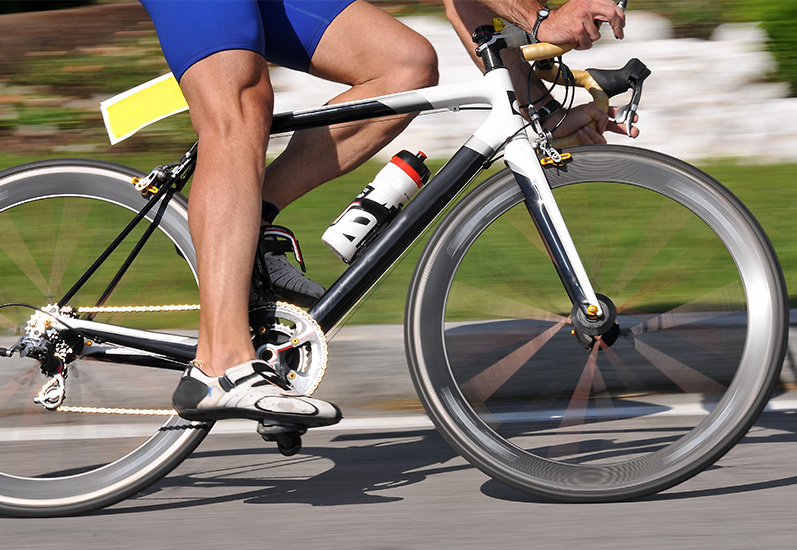
Other Non-Invasive Therapies
The most effective non-invasive therapy for varicose veins involves using compression stockings. These stockings are classified as prescription vs. non-prescription stockings. They can be knee-high, thigh-high, or panty-hose style. Prescription stockings are much more effective than non-prescription stockings in the management of venous disease. Stocking slow the worsening and spread of varicose veins. Stockings also help to relieve many of the symptoms that people experience when they have varicose veins, such as pain, swelling, and leg fatigue. They can be very beneficial during pregnancy since stockings help decrease leg symptoms, diminish the degree to which varicose veins worsen, and help prevent blood clots.
Compression stockings can slow the development of varicose veins in people who are genetically prone to them. Compression stockings also tend to decrease the incidence of certain varicose vein complications, including phlebitis. Stockings do not cure the condition and they do not cause the varicose veins to shrink, fade, or disappear. Varicose veins will still tend to gradually enlarge and multiply, even when compression stockings are used regularly.
In addition to compression stockings, certain natural supplements such as horse chestnut and Diosmin can often help to diminish vein inflammation and decrease leg symptoms.
Cure For Varicose Veins
The best way to cure varicose veins is to undergo interventional treatments by a board-certified vein specialist, known as a vascular surgeon. The earlier that varicose veins are treated the easier they are to treat and cure. Please contact our Vein Treatment Center in order to have us determine the treatment options that are best for you.
To arrange a consultation with one of our specialists, please give us a call directly at (512) 220-5401 or send us a message via the online contact form.
